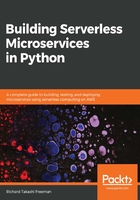
Overview of microservices
The term microservice arose from a workshop in 2011, when different teams described an architecture style that they used. In 2012, Adrien Cockcroft from Netflix actually described microservice as a fine-grained SOA who pioneered this fine-grained SOA at web scale.
For example, if we have sensors on an Internet of Things (IoT) device, if there's a change of temperature, we would emit an event as a possible warning further downstream. This is what's called event-stream processing or complex-event processing. Essentially, everything is driven by events throughout the whole architecture.
The other type of design used in microservices is called domain-driven design (DDD). This is essentially where there is a common language between the domain experts and the developers. The other important component in DDD is the bounded context, which is where there is a strict model of consistency that relies in its bounds for each service. For example, if it's a service dealing with customer invoicing, that service will be the central point and only place where customer invoicing can be processed, written to, or updated. The benefits are that there won't be any confusion around the responsibilities of data access with systems outside of the bounded context.
You could think of microservice as centered around a REST endpoint or application programming interface using JSON standards. A lot of the logic could be built into the service. This is what is called a dumb pipeline but a smart endpoint, and you can see why in the diagram. We have a service that deals with customer support, as follows:

For example, the endpoint would update customer support details, add a new ticket, or get customer support details with a specific identifier. We have a local customer support data store, so all the information around customer support is stored in that data store and you can see that the microservice emits customer-support events. These are sent out on a publish-subscribe mechanism or using other publishing-event frameworks, such as Command Query Responsibility Segregation (CQRS). You can see that this fits within the bounded context. There's a single responsibility around this bounded context. So, this microservice controls all information around customer support.